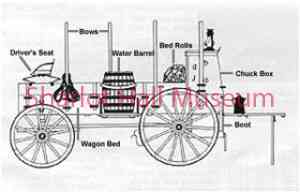By Susan Cypert
Besides cowboys, there is probably no more quintessential symbol of the Old West than the chuckwagon.
Some pioneers drove versions of mobile kitchens across the plains on their way West, but the chuckwagon as we know it was specifically invented for Texas cowboys who were driving herds thousands of miles to market or the nearest railroad, or for roundups that might last for months. Before the chuckwagon, each cowboy was responsible for his own food and had to make do with what little he could carry.
 The chuckwagon is generally attributed to Charles Goodnight, a Texas rancher and one of the founders of the Goodnight-Loving Trail. The competition for good cowboys was stiff among ranchers, and Goodnight saw the creation of the chuckwagon as an opportunity to lure the best cowboys.
The chuckwagon is generally attributed to Charles Goodnight, a Texas rancher and one of the founders of the Goodnight-Loving Trail. The competition for good cowboys was stiff among ranchers, and Goodnight saw the creation of the chuckwagon as an opportunity to lure the best cowboys.
So, in 1866, he hired a cook and together they developed a prototype. They outfitted a solid and durable army-surplus wagon with steel axles to handle rough terrain and added boxes, shelves and drawers. They designed a “chuck box” at the back of the wagon, a sloping box with a hinged lid that, when open, lay flat to serve as a work surface. Inside the box were drawers and shelving to hold pots, pans and cooking tools, as well as non-perishable supplies. Beneath the chuck box was the “boot” for larger items like cast iron Dutch ovens. A “fly” or canvas awning was attached to the top of the chuck box which could be rolled out as a cover in case of rain.
In front was the “jockey box” for tools and heavier equipment. Strapped to the sides were water containers, coffee pots, shovels and axes, and the wagon bed itself was used to carry personal items, bed rolls, bulk food supplies, feed for horses, medicine and necessary sundries. Important food items included coffee beans (Arbuckles was a favorite), dried beans, flour, salt, sugar, lard, salt pork and jerky and, most importantly, sourdough starter in a crock that “Cookie” never let out of his sight. According to Kent Rollins, chuckwagon cook for 30 years, chuckwagons were the first “meals on wheels”.
 The name is attributed to two different sources: first, to Charles “Chuck” Goodnight, the inventor, and second and most likely, to “chuck”, slang for food.
The name is attributed to two different sources: first, to Charles “Chuck” Goodnight, the inventor, and second and most likely, to “chuck”, slang for food.
Trail drives were often 1,000 miles and cattle roundups could last for months, so the cook became a very important member of the team, often second only to the trail boss. Breakfast and dinner around the campfire were the only real benefits on these trips, and the morale of the cowboys and the smooth running of the camp largely depended on the cook.
The cook’s job didn’t require the same kind of effort as the cowboy’s, but he was always operating on a lot less sleep than they were. He was up by 3 AM to have the coffee, biscuits and breakfast ready for the crew. After they left, he washed, dried and packed up dishes and cooking pots, bedrolls and food supplies, and hitched up the team to move on.
On the way to the next camp, he was on the constant lookout for fuel, including wood and cow chips, and food items that could be gathered. He moved faster than the crew and herd in order to reach the next camp, get set up and have coffee and a hot dinner ready by the time the cattle and crew arrived.
At the end of his day, the cook would place the tongue of the chuckwagon facing north in the direction they would be moving the herd in the morning.
Next week, chuckwagon terms, cowboy etiquette and favorite recipes.
Days Past” is a collaborative project of the Sharlot Hall Museum and the Prescott Corral of Westerners International (www.prescottcorral.org). This and other Days Past articles are also available at archives.sharlothallmuseum.org/articles/days-past-articles/1. The public is encouraged to submit proposed articles and inquiries to dayspast@sharlothallmuseum.org. Please contact SHM Research Center reference desk at 928-445-3122 Ext. 2, or via email at archivesrequest@sharlothallmuseum.org for information or assistance with photo requests.


